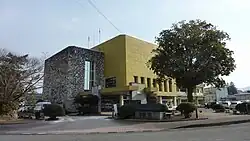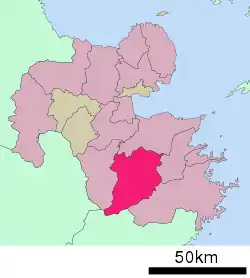Bungo-Ōno
Bungo-Ōno (豊後大野市, Bungo-Ōno-shi) is a city located in Ōita Prefecture, Japan.
Bungo-Ōno
豊後大野市 | |
|---|---|
 Bungo-Ōno City Office | |
 Flag  Chapter | |
 Location of Bungo-Ōno in Ōita Prefecture | |
 Bungo-Ōno Location in Japan | |
| Coordinates: 32°59′N 131°35′E | |
| Country | Japan |
| Region | Kyushu |
| Prefecture | Ōita Prefecture |
| Government | |
| • Mayor | Fumitoshi Kawano (since April 2017) |
| Area | |
| • Total | 603.36 km2 (232.96 sq mi) |
| Population (March 1, 2017) | |
| • Total | 35,811 |
| • Density | 59/km2 (150/sq mi) |
| Time zone | UTC+09:00 (JST) |
| City hall address | 1200 Mie-cho Ichiba, Bungo-ono-shi, Oita-ken 879-7198 |
| Climate | Cfa |
| Website | www |
| Symbols | |
| Flower | Phoney cherry |
| Tree | Quercus acutissima |
The modern city of Bungo-Ōno was established on March 31, 2005, from the merger between the towns of Asaji, Inukai, Mie, Ogata and Ōno, and the villages of Chitose and Kiyokawa (all from Ōno District).
As of March 1, 2017, the city has an estimated population of 35,811 and a population density of 59 persons per km².[1] The total area is 603.36 km².
In 2012, the growing deer population began to greatly affect the shiitake mushroom farming industry.[2]

Geography
Climate
Bungo-Ōno has a humid subtropical climate (Köppen climate classification Cfa) with hot summers and cool winters. Precipitation is significant throughout the year, but is somewhat lower in winter. The average annual temperature in Bungo-Ōno is 15.3 °C (59.5 °F). The average annual rainfall is 1,791.8 mm (70.54 in) with June as the wettest month. The temperatures are highest on average in August, at around 26.4 °C (79.5 °F), and lowest in January, at around 4.5 °C (40.1 °F).[3] The highest temperature ever recorded in Bungo-Ōno was 39.0 °C (102.2 °F) on 27 July 2008; the coldest temperature ever recorded was −8.5 °C (16.7 °F) on 11 February 1996.[4]
| Climate data for Inukai, Bungo-Ōno (1991−2020 normals, extremes 1977−present) | |||||||||||||
|---|---|---|---|---|---|---|---|---|---|---|---|---|---|
| Month | Jan | Feb | Mar | Apr | May | Jun | Jul | Aug | Sep | Oct | Nov | Dec | Year |
| Record high °C (°F) | 21.5 (70.7) |
24.3 (75.7) |
28.5 (83.3) |
31.6 (88.9) |
36.1 (97.0) |
35.4 (95.7) |
39.0 (102.2) |
38.7 (101.7) |
36.3 (97.3) |
32.2 (90.0) |
29.9 (85.8) |
23.7 (74.7) |
39.0 (102.2) |
| Average high °C (°F) | 10.6 (51.1) |
11.9 (53.4) |
15.4 (59.7) |
20.9 (69.6) |
25.1 (77.2) |
27.1 (80.8) |
31.4 (88.5) |
32.4 (90.3) |
28.4 (83.1) |
23.3 (73.9) |
17.9 (64.2) |
12.6 (54.7) |
21.4 (70.5) |
| Daily mean °C (°F) | 4.5 (40.1) |
5.5 (41.9) |
8.9 (48.0) |
13.9 (57.0) |
18.5 (65.3) |
21.8 (71.2) |
25.8 (78.4) |
26.4 (79.5) |
22.7 (72.9) |
17.2 (63.0) |
11.6 (52.9) |
6.4 (43.5) |
15.3 (59.5) |
| Average low °C (°F) | −0.6 (30.9) |
0.1 (32.2) |
3.2 (37.8) |
7.8 (46.0) |
12.8 (55.0) |
17.7 (63.9) |
21.9 (71.4) |
22.3 (72.1) |
18.7 (65.7) |
12.4 (54.3) |
6.4 (43.5) |
1.3 (34.3) |
10.3 (50.6) |
| Record low °C (°F) | −8.1 (17.4) |
−8.5 (16.7) |
−6.6 (20.1) |
−2.5 (27.5) |
1.0 (33.8) |
8.1 (46.6) |
13.2 (55.8) |
15.4 (59.7) |
6.3 (43.3) |
0.6 (33.1) |
−2.9 (26.8) |
−7.5 (18.5) |
−8.5 (16.7) |
| Average precipitation mm (inches) | 47.6 (1.87) |
63.2 (2.49) |
98.3 (3.87) |
112.8 (4.44) |
131.9 (5.19) |
325.7 (12.82) |
287.1 (11.30) |
204.8 (8.06) |
271.6 (10.69) |
132.3 (5.21) |
69.6 (2.74) |
46.9 (1.85) |
1,791.8 (70.54) |
| Average precipitation days (≥ 1.0 mm) | 5.4 | 7.1 | 9.9 | 9.4 | 9.3 | 14.6 | 12.4 | 10.9 | 10.9 | 7.2 | 6.9 | 5.2 | 109.2 |
| Mean monthly sunshine hours | 156.3 | 150.7 | 172.9 | 187.1 | 187.2 | 125.9 | 175.4 | 197.8 | 150.9 | 167.5 | 152.2 | 157.5 | 1,981.6 |
| Source: Japan Meteorological Agency[4][3] | |||||||||||||
Demographics
Per Japanese census data, the population of Bungo-Ōno in 2020 is 33,695 people.[5] Bungo-Ōno has been conducting censuses since 1960.
| Year | Pop. | ±% |
|---|---|---|
| 1960 | 74,803 | — |
| 1965 | 65,943 | −11.8% |
| 1970 | 58,312 | −11.6% |
| 1975 | 53,513 | −8.2% |
| 1980 | 51,975 | −2.9% |
| 1985 | 50,011 | −3.8% |
| 1990 | 47,034 | −6.0% |
| 1995 | 45,191 | −3.9% |
| 2000 | 43,371 | −4.0% |
| 2005 | 41,548 | −4.2% |
| 2010 | 39,459 | −5.0% |
| 2015 | 36,584 | −7.3% |
| 2020 | 33,695 | −7.9% |
| Bungo-Ōno population statistics[5] | ||
References
- "Official website of Bungo-ōno city" (in Japanese). Japan: Bungo-ōno City. Retrieved 21 April 2017.
- "If the Japanese Diet Included Deer, It might Keep Wolves from the Door". Wall Street Journal. December 28, 2012.
- 気象庁 / 平年値(年・月ごとの値). JMA. Retrieved April 27, 2022.
- 観測史上1~10位の値(年間を通じての値). JMA. Retrieved April 27, 2022.
- Bungo-Ōno population statistics
External links
- Bungo-ōno City official website (in Japanese)